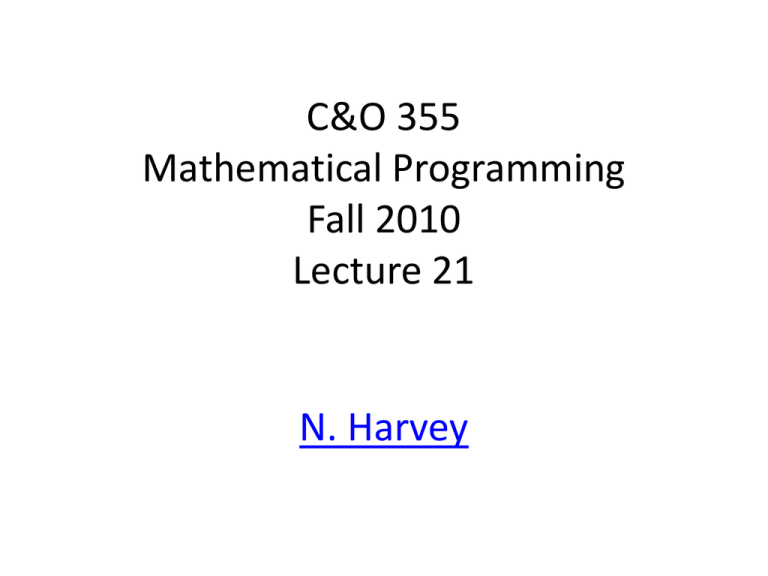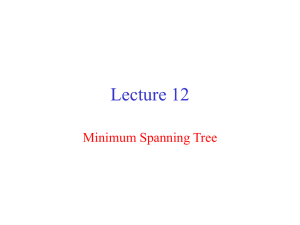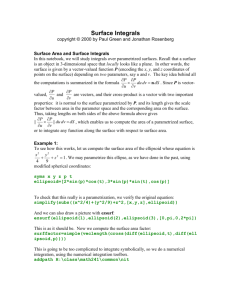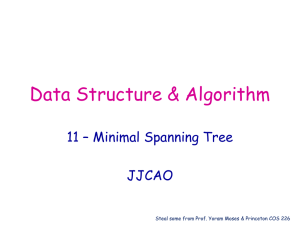PPTX
advertisement

C&O 355
Mathematical Programming
Fall 2010
Lecture 21
N. Harvey
Topics
• Max Weight Spanning Tree Problem
• Spanning Tree Polytope
• Separation Oracle using Min s-t Cuts
Warning!
The point of this lecture is to do things
in an unnecessarily complicated way.
Spanning Tree
• Let G = (V,E) be a connected graph, n=|V|, m=|E|
• Edges are weighted: we2R for every e2E
• Def: A set TµE is a spanning tree if (these are equivalent)
– |T|=n-1 and T is acyclic
– T is a maximal acyclic subgraph
– T is a minimal connected, spanning subgraph
3
5
4
7
8
1
1
2
2
8
1
2
1
3
2
Spanning Tree
• Let G = (V,E) be a connected graph, n=|V|, m=|E|
• Edges are weighted: we2R for every e2E
• Def: A set TµE is a spanning tree if (these are equivalent)
– |T|=n-1 and T is acyclic
– T is a maximal acyclic subgraph
– T is a minimal connected, spanning subgraph
3
5
4
7
8
1
1
2
2
8
1
2
1
3
2
Spanning Tree
• Let G = (V,E) be a connected graph, n=|V|, m=|E|
• Edges are weighted: we2R for every e2E
• Def: A set TµE is a spanning tree if (these are equivalent)
– |T|=n-1 and T is acyclic
– T is a maximal acyclic subgraph
– T is a minimal connected, spanning subgraph
• Def: TµE is a max weight spanning tree if it
maximizes e2T we over all spanning trees.
3
5
1
4
7
8
8
1
1
1
2
2
3
2
2
A Simple Properties of Trees
• For any CµE, let ∙(C) = # connected components in (V,C)
• Examples: ∙(E)=1 and ∙(;)=n
• Claim: Suppose T is a spanning tree.
For every CµE, |TÅC| · n-∙(C).
• Proof: Let the connected components of (V,C) be
(V1,C1), (V2,C2), ....
• So V = [i Vi and C = [i Ci.
• Since TÅCi is acyclic, |TÅCi|·|Vi|-1.
• So
¥
Characteristic Vectors
• Notation: We consider vectors x assigning real numbers
to the edges in E. We write this as x 2 RE.
• Notation: For CµE, let x(C) = e2C xe.
• Examples:
– the edge weights are w 2 RE
– For TµE, the characteristic vector of T is x2RE where
For any CµE, x(C) = |TÅC| · n-∙(C).
This is a linear inequality in x: e2C xe · n-∙(C)
Spanning Tree Polytope
• Since we know all these linear inequalities,
why not assemble them into a polyhedron?
• Let PST =
• Note:
– PST is a polyhedron, because x(E) and x(C) are
linear functions of x
– PST is a polytope, because xe= x({e}) · 1,
so PST is bounded
– If x is the characteristic vector of a spanning tree,
then x2PST
The Main Theorems
• Theorem 1: The LP max { wTx : x2PST } can be
solved in polynomial time.
(In fact, we’ll do this by the ellipsoid method!)
• Theorem 2: [Edmonds ‘71]
The extreme points of PST are precisely the
characteristic vectors of spanning trees of G.
• Corollary: A max weight spanning tree can be found
in polynomial time.
• Proof: Solve the LP and find an extreme point x.
x is the characteristic vector of a tree T of weight wTx.
Since wTx ¸ wTy for any other extreme point y,
it follows that T is a max weight spanning tree. ¥
“Polynomial Time”
• There are many algorithms for finding
maximum weight spanning trees
Name
Running Time
Prim’s Algorithm
O(m log n)
Kruskal’s Algorithm
O(m log n)
...with fancy data structures
O(m + n log n)
...even fancier data structures
O(m ®(m,n))
Karger-Klein-Tarjan Algorithm
O(m)
Pettie-Ramachandaran Algorithm
Optimal determistic alg,
but runtime is unknown
(randomized)
• Our algorithm has running time something like O(m12)
• Hopelessly impractical! But illustrates important ideas.
Ellipsoid Method for Solving LPs
(from Lecture 8)
• Ellipsoid method can find a feasible point in P
i.e., it can solve a system of inequalities
• But we want to optimize, i.e., solve max { wTx : x2P }
• One approach: Binary search for optimal value
–
–
–
–
Suppose we know optimal value is in interval [L,U]
Add a new constraint wTx ¸ (L+U)/2
If LP still feasible, replace L with (L+U)/2 and repeat
If LP not feasible, replace U with (L+U)/2 and repeat
wTx¸(L+U)/2
wTx = L
P
wTx = U
Applying the Ellipsoid Method
• By binary search, we need to decide feasibility of
PST =
• Main obstacle: Huge number of constraints! (2m)
• Recall: Ellipsoid method works for any convex set P,
as long as you can give a separation oracle.
Separation Oracle
Is z2P?
If not, find a vector a s.t. aTx<aTz 8x2P
Applying the Ellipsoid Method
• By binary search, we need to decide feasibility of
PST =
• Main obstacle: Huge number of constraints! (2m)
• Recall: Ellipsoid method works for any convex set P,
as long as you can give a separation oracle.
Separation Oracle
Is z2P?
If not, find a violated constraint.
• How quickly can we test these constraints?
• We’ll show: This can be done in time polynomial in n.
Ellipsoid method inside Ellipsoid method
Everything runs in
polynomial time!
Minimum Spanning Tree Problem
Solve by Ellipsoid Method
Separation oracle uses…
Minimum S-T Cut Problem
Solve by Ellipsoid Method!
Separation Oracle:
Game Plan
• We have graph G=(V,E) and a point z2RE
• We construct digraph D=(N,A) with capacities c2RA
• If s-t min cut in D is:
– Small: this shows that z violates a constraint of P
– Large: this shows that z is feasible for P
G=(V,E)
Construction of D
1
0.7
Edge b, zb = 0.7
Edge a
za = 0.6
D=(N,A)
Edge d, zd = 0.9
Edge c, zc = 0.8
s
0.6
0.8
1
ub
1
1
uc
1
1
1
1
1
ua
t
1
1
ud
1
0.9
• Nodes of D: N = V [ {s,t} [ { ue : e 2 E }
• Arcs of D:
– Arc (s,ue) of capacity ze for every edge e 2 E
– Arc (v,t) of capacity 1 for every node v2V
– Infinite capacity arcs (u{v,w},v) and (u{v,w},w) for all {v,w} 2 E
G=(V,E)
Construction of D
1
0.7
Edge b, zb = 0.7
Edge a
za = 0.6
D=(N,A)
Edge d, zd = 0.9
Edge c, zc = 0.8
s
0.6
0.8
1
ub
1
1
uc
1
1
1
1
1
ua
t
1
1
ud
1
0.9
• Lemma: z is feasible , every s-t cut has capacity ¸ n
(except for the cut with only black edges).
G=(V,E)
Construction of D
U
Edge b, zb = 0.7
Edge a
za = 0.6
Edge d, zd = 0.9
Edge c, zc = 0.8
D=(N,A)
1
0.7
s
0.6
0.8
1
ub
1
1
uc
1
1
1
1
1
ua
t
1
1
ud
1
0.9
• Lemma: z is feasible , every s-t cut has capacity ¸ n
(except for the cut with only black edges).
• Example:
– z(C) = 2.1 > n-∙(C) = 2, so z is infeasible.
– The s-t cut ±+(U) in D has capacity 3.9 < n = 4.
Separation Oracle Summary
• Input: G=(V,E) and z2RE
• Construct the graph D=(N,A) and arc capacities
• For each v2V
– Temporarily add an infinity capacity arc (s,v)
– Compute the s-t min cut value q
(by the Ellipsoid Method)
– If q<n
• We obtain a set SµV s.t. z(E[S]) > |S|-1
• Halt: return this violated constraint
– Remove the temporary arc
• End for
• Halt: z is feasible
Summary
• Some combinatorial objects are described by
LPs of exponential size
• Even if an LP has exponential size, the ellipsoid
method might be able to solve it “efficiently”,
if a separation oracle can be designed
• The separation oracle might use ellipsoid method too
• Ellipsoid method gives impractical algorithms, but
these can be a “proof of concept” for realistic
algorithms










